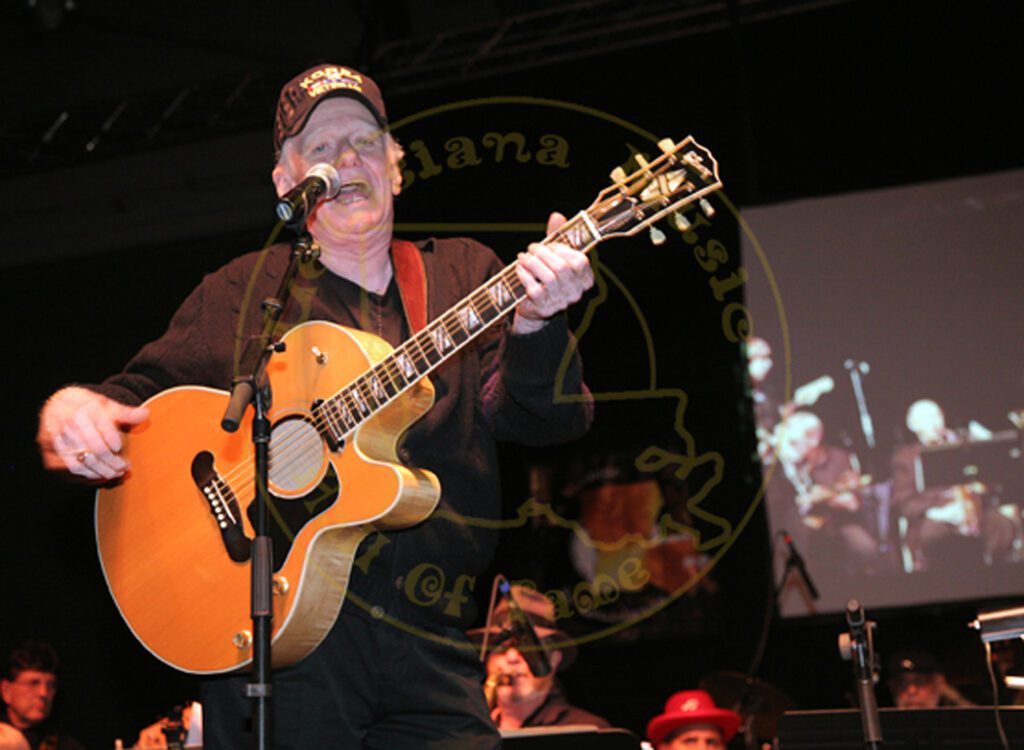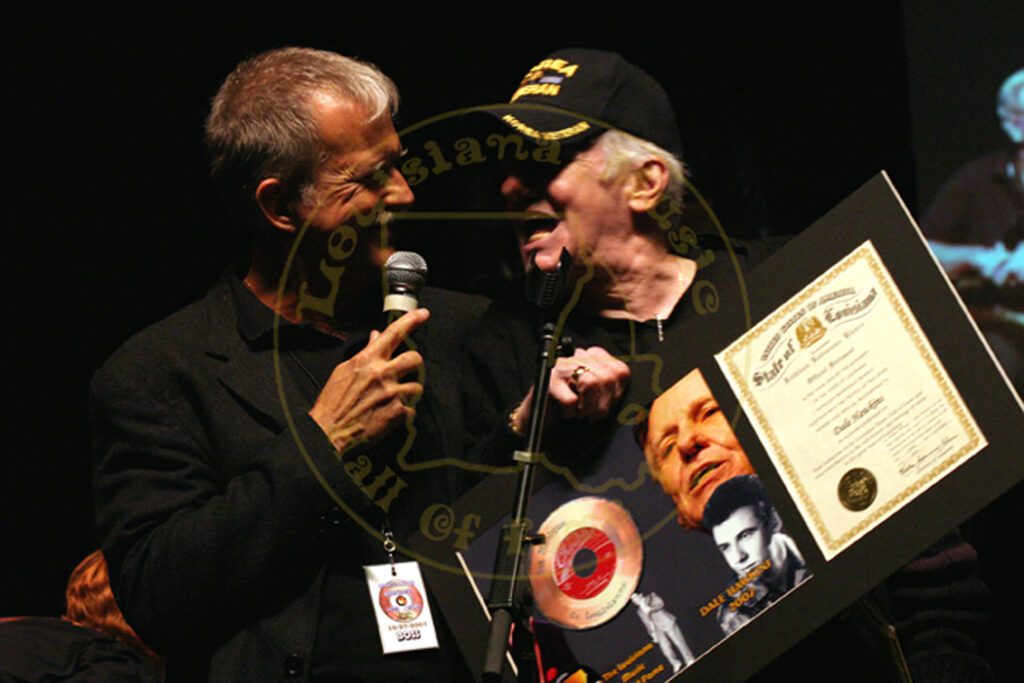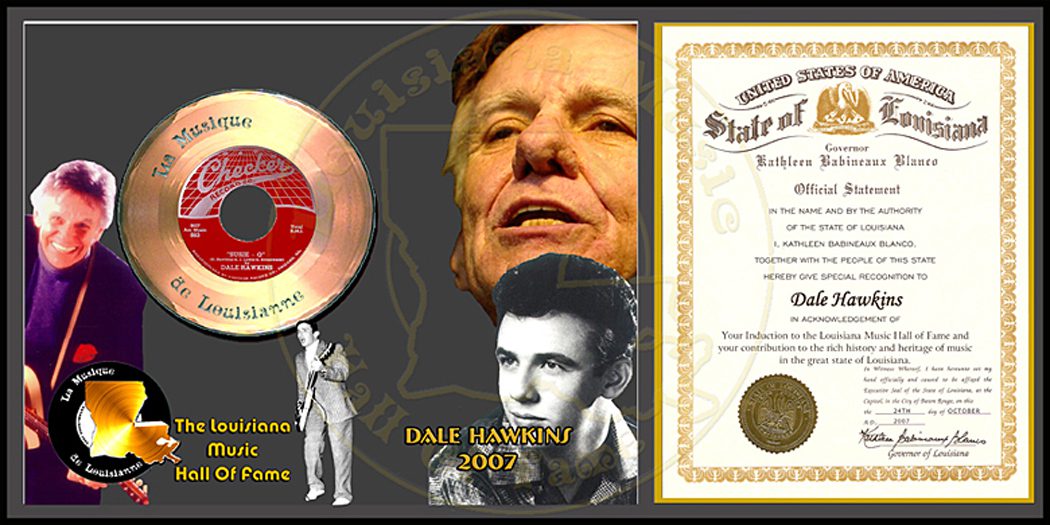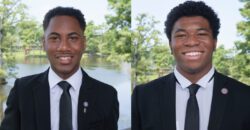Brought To You By The Louisiana Music Hall Of Fame
At the first Ponderosa Stomp in New Orleans in 2002, New Orleans songwriter, pianist, and record producer, Allen Toussaint, was looking over merchandise at a souvenir booth when a woman asked him if he knew Dale Hawkins. Toussaint, a man described as quiet, unassuming, and almost shy, never looked up. “Well, everybody knows Dale Hawkins,” was his gentle response.
Born Delmar Allen Hawkins on August 22, 1938, in the village of Goldmine, Louisiana, he was an early innovator of American rock & roll as a singer, songwriter, and rhythm guitar player. “Goldmine is near Mangham, Louisiana,” Hawkins said, laughing. “If you don’t know where Mangham is, it’s just up the road from Jerry Lee Lewis’s hometown of Ferriday and if you don’t know where that is, it’s just across the Mississippi River from Natchez, Mississippi. Beyond that, I can’t help you much.” His mother was a schoolteacher at the tiny community’s only school and his father was a sharecropper.
“My father paid the doctor who delivered me two dollars a month until the twelve dollar delivery fee was paid in full,” he said.
His parents separated when he was three and his father subsequently died in a fire. Dale was shuttled back and forth among a succession of share-cropping relatives in the Mangham area. It was while working in the cotton fields that he first became exposed to blues as he toiled alongside black field hands. It was also while attending elementary school that he met Carl Adams. Adams had lost two fingers at age five in a tragic shotgun accident that killed his two-year-old cousin. He became one of a succession of skilled guitarists who worked with Hawkins during an outstanding career that has spanned nearly half a century. Others included Joe Osborne, Roy Buchanan, and James Burton of Shreveport and West Monroe’s Kenny Bill Stinson.
Hawkins joined the Navy at age sixteen and upon his discharge a year-and-a-half later, took a job as a counter clerk in Stan’s Record Shop in Shreveport. The store was owned and operated by Stan Lewis who was instrumental in the recording career of his clerk as well as many other performers in the Shreveport and East Texas area. The jukeboxes of the time were loaded with the Chess-Checker records of Howlin’ Wolf, Lonnie Johnson, and Guitar Slim. Hawkins became an authority on the R&B hits as he sold them by day and sang them at night in various dives along the Bossier Strip. The clubs of the infamous strip catered to military personnel stationed at Barksdale AFB who found easy access to prostitutes and drugs as well as non-stop liquor.
As a young man, Hawkins, like many of his contemporaries, found himself at the right place at the right time with the right sound.
America was emerging from the post-war doldrums. Teenagers were weary of the endless list of stodgy ballads churned out by boring crooners with the complicity of the handful of unimaginative major recording companies that monopolized the music industry. The time was never better for white acceptance of rhythm & blues. It was also the right time for “hillbilly” music, to morph into a hybrid called rockabilly. Abetting this cultural revolution were scores of independent recording companies from New Orleans, Shreveport, Memphis, Chicago, Los Angeles, and New York. Even primitive studios in towns like Baton Rouge, Lafayette, Houston, and Lake Charles as well as in hamlets like Crowley and Ville Platte got in on the action. In short, the timing was right for anyone anywhere to take advantage of the blase attitudes permeating the boardrooms of the four major recording companies.
And radio, to be sure, was positioned perfectly to take full advantage of this fortuitous trifecta of good timing.
Into the breach stepped the likes of Hank Williams, Elvis Presley, Johnny Cash, D. J. Fontana, Floyd Cramer, James Burton, and Dale Hawkins, all regulars on the Louisiana Hayride. In 1956, Hawkins, while playing the clubs along the Bossier Strip, began experimenting with a song he’d written. The song, influenced by what Scotty Moore was doing on guitar for Elvis, still had its own Louisiana sound that featured a heavy blues influence.
“It took five months for me to get Suzie Q right,” Hawkins said, “and in 1957 we paid KWKH engineer Bob Sullivan $25 for studio time when the station went off the air at midnight for equipment changes. Sullivan was the engineer on the song and I was the producer. It took us seven takes to get it down right,” he said. Besides Hawkins, the band included bassist Joe Osborne, Stan Lewis’s brother, Ronnie Lewis, on drums, and fifteen-year-old future Rock & Roll Hall of Fame member James Burton on lead guitar. All were from Shreveport.
Susie Q kicked off with the rhythmic beat of a cowbell as Burton fell in on guitar before Hawkins came in on the vocal. “It was a one-track recording because we didn’t have multi-track tapes back then,” Hawkins said. “Our band had the riffs for Suzie Q for some time, and we kept putting them together until one day I finally said, ‘That’s it.’”
He said. “It was just sheer sound and it worked. We went into KWKH in Shreveport to cut the song. I know that sounds unusual today, but they used to do a lot of recording there.”
The tape was sent to Chess Records in Chicago because his boss, Stan Lewis, had once worked with Leonard Chess before moving back to Shreveport. Leonard Chess told Hawkins he wanted the song but after several weeks passed with no word from Chess, Hawkins sent a copy of the tape to Jerry Wexler at Atlantic Records and Wexler put the word out that if Chess wasn’t interested, he was. Two weeks later, Chess released the record and it broke in different parts of the country at different times. “We knew it was a hit after only a week and a half,” Hawkins said. Independent labels like Chess were coming into their own about this time because major labels like Capitol, Columbia, Decca, and RCA weren’t interested in the new sound of popular music, which they considered a passing fad.
It was Stan Lewis, taking advantage of his friendship with Leonard Chess (he was the biggest distributor of Chess and Checker records in Louisiana), that resulted in the management deal with the Chicago record label. “The special sound of the guitar was a reverb technique they added in Chicago,” Hawkins said. “The basic sound was ours, though, heavy on Louisiana influence, with some blues.”
Payola can take on many forms, from cash to gifts to vacations for deejays who promote records. Sometimes it can even adversely affect an artist. In the case of Suzie Q, Hawkins and Burton collaborated to compose the song, but when Chess issued the record, Burton was not credited. Writers named on the Suzie Q record were Hawkins, Stan Lewis, and Eleanor Broadwater. Broadwater, it turned out, was the maiden name of the wife of WLAC deejay Gene Nobles. The one-third of composing royalties was Chess’s way of thanking Nobles for promoting the label’s records on the Nashville station.
Author Jeff Hannusch called Suzie Q “perhaps the most influential and original-sounding rockabilly record of all time,” adding that it was “two minutes and sixteen seconds of flawless music.” Rock & Blues News said it was a record “that helped define just exactly what was (and what was not) rock ‘n’ roll.”
Suzie Q was chosen as one of the Rock & Roll Hall of Fame’s 500 Songs that Shaped Rock & Roll and Offbeat Magazine, a New Orleans publication, included the song on its list of the 100 Most Essential Louisiana CDs. Creedence Clearwater Revival covered the song to launch the career of CCR and John Fogerty in 1968.
Suzie Q climbed all the way to number 27 on the Billboard Hot 100 in July of 1957 and number seven on the R&B chart. It remained on the pop chart for nineteen weeks. Hawkins followed that with La-Do-Dada (number 32) in October 1958, A House, A Car And A Wedding Ring (number 88) in December of 1958, and Class Cutter (number 52) in April 1959. He was smart enough to draw on his early experience in production in the KWKH studios with Merle Kilgore and Johnny Horton. He turned that experience into a successful career in producing hits for Joe Stampley and The Uniques (Not too Long Ago), The Five Americans (Western Union), and Bruce Channel (Mr. Bus Driver), as well as songs by The In Crowd, Michael Nesmith, John Fred, Ronnie Self, and Harry Nilsson. He worked for a time as A&R (Artist & Repertoire) representative for RCA Records. In that capacity, he scouted for rock & roll groups all over the country, but mainly in the Texas-Arkansas-Louisiana area. “If anyone can sniff out a funky-rock hit, he can,” said Dick Moreland, West Coast Manager of Rock Music for RCA. Along the way, he also hosted The Big Beat, aka The Dale Hawkins Show on WCAU-TV in Philadelphia.
Only four of his songs made the charts, but he continued to perform. In 1998, Ace Records released a compilation CD, Dale Hawkins, Rock ‘n’ Roll Tornado. In 1999, he released his first new CD in thirty years, Wildcat Tamer, which got rave reviews in Rolling Stone. A member of the Rockabilly Hall of Fame who lived in Arkansas, he played events throughout the U.S., including New Orleans Jazz Fest and the Ponderosa Stomp. “Cream of the crop at the Stomp,” one fan said of his performance at the 2002 Ponderosa Stomp. “He had more energy than any performer that night.”
Rock & Roll News called Hawkins “a master of swamp rock, lowdown boogie, and straight ahead rock ‘n’ roll.” High Times said he had “the type of wild genius it takes to create truly inspired rock & roll.”
One of the more original assessments of his work as an independent producer and performer came from Bruce Sylvester of Goldmine Magazine, who said Hawkins “kicks mega-budget corporate rock’s ugly, flabby butt straight across Louisiana” and that he “returns rock & roll to its roots like few other ‘50s originals can still do.”
It may be one thing to reap the praises of rock critics, but quite another when fellow performers contribute their own plaudits. Roy Buchanan, one of several top guitarists who worked with Hawkins through the years, said of a performance with Hawkins:
“I was adequate, but Dale would really make you work. He wouldn’t leave you alone for a second and I was all for that.”
The Dale Hawkins Band’s lasting legacy is that it created the link that bridged rockabilly and the heavy guitar blues rock of the British Invasion – the missing link between Hank Williams and Elvis Presley and the Yardbirds and Led Zeppelin.
The Ponderosa Stomp moved to Memphis in the spring of 2006 after Hurricane Katrina devastated New Orleans the previous year. Hawkins, who was scheduled to perform, had to cancel when he was diagnosed with colon cancer. On February 9, 2006, he posted a message on the Dale Hawkins News web page in which he said he left the hospital on February 8 following his fourth chemo treatment. “My doctor went over my progress since the operation with a smile,” he said.
“My white blood count was back to normal and all of the other charts that he showed me were beautiful. I have not had any bad side effects from the chemo. I am starting to get my strength back and my attitude is still on its positive kick-ass mode. I am continuing with the treatment and with your prayers and by the grace of God (I) will win. Thank you!!”
Another message posted on his condition on May 25 said he had gained weight and doctors were pleased with his progress.
“Many of you who have been aware have been so supportive and he extends his thanks to all for the prayers, cards, emails, calls, and overall concern,” it said. He appeared in Baton Rouge on October 27, 2007 at the LMHOF. Hawkins passed in 2010.

Dale performs “Susie Q” at Louisiana’s Greatest Hits – LIVE!

Mike Shepherd & Dale Hawkins – 10-27-2007, at that event, Hawkins was inducted into The Louisiana Music Hall Of Fame























